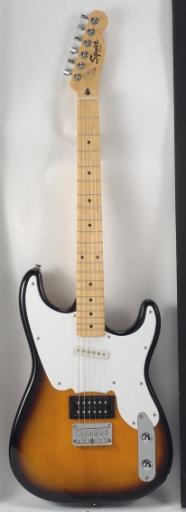MusicRadar Verdict
Squier is going to sell container-loads of each of these. The RRP is well below what we'd be prepared to pay.
Pros
- +
The top new look and old school vibe.
Cons
- -
The bridge humbucker can be a little brash.
MusicRadar's got your back
Squier has to be one of the very few brands that everyone has played, owned or considered and, unlike another 'sister' brand we could mention, levels of build quality have, for the most part, remained consistently acceptable.
Over the last 18 months, Squier has captured imaginations with the Series 24 and the more metal-influenced guitars of the Showmaster range, yet the most enduring Squier models are always likely to be those steeped in Fender-associated history.
Here we look at a new addition to the Vintage Modified series that shows its roots with pride…
Overview
This is a brand new model that combines traits from the Strat, Tele and, interestingly, P-bass. And it's due to the influence (and debut year) of the latter instrument that the guitar has been dubbed the '51.
The very first P-basses were produced in October 1951 to be subsequently promoted by the likes of 'where are they now?' file occupants Shifte Henri and Wade Ray.
Facets of this classic four-stringer that have made it on to the '51 include the unmistakeable single-ply scratchplate - fixed by 11 rather than seven screws, fact fans - and the truncated two-knob control panel.
The two-piece basswood body, however, is all Stratocaster and it's certainly worth mentioning that it hasn't been routed for three single-coils under the scratchplate, proving this is a specific design - without doubt a creditable move on Squier's part.
Want all the hottest music and gear news, reviews, deals, features and more, direct to your inbox? Sign up here.
Electrics are courtesy of an uncommon H/S configuration, comprising a Squier 'hot' humbucker and Strat single-coil, and the mix of cover colours also echoes the P-bass vibe, albeit probably unintentionally.
Another cool feature is the second knob as, instead of it simply being a straight-forward tone control, it's actually a three-way rotary pickup selector that combines the coils in the usual T-type manner - the volume pot doubles as a push/pull coil-split too.
The headstock gives away the third of the '51's classic influences, the good old Telecaster, and the neck itself is hewn from a single piece of maple, almost unheard of at this end of the market.
The wood, which is of a decent grade too, has been lightly finished with a matt polyurethane and given a vintage tint that, thankfully, isn't of the lurid orange variety that can be found on certain reissues.
The 21 frets are slightly more substantial than those of a standard Telecaster and are a little on the proud side too, especially at the edges.
However, this is in no way obstructive to a feel that is pure contemporary Fender and we have to say that although this and all Squier guitars come out of the box strung with .009-.042-inch gauge, this particular '51 was set-up perfectly.
Sounds
With both pickups mounted straight to the body, the initial tone is woody and organic, even though the humbucker is a little on the unsubtle side, especially when played cleanly.
Of course you get your money back in the rock arena as, with a nice big overdrive, all the harmonics and overtones are pushed to the fore to give a cutting, aggressive and very satisfying crunch.
The rotary's middle setting combines all three coils in parallel to offer a tone similar to a Strat's fourth position, although with added beef and body upping the chunk factor to ensure big chords are full and breezy.
With more gain, the tone here is similar to The Black Crowes' best moments, while flicking to the single-coil gives you a ticket to SRV-land: the striving urgency nicely offset by middly girth.
Add the coil-split and positions one and two offer yet more possibilities. We have another three guitars to look at, so let's just say that the '51 is a winner in all areas and leave it at that.
The '51 is a genuinely new design and as such it works very well indeed. It demands attention regardless of your stature and the size of your wallet. We really can't put it any more strongly than that.
Guitarist is the longest established UK guitar magazine, offering gear reviews, artist interviews, techniques lessons and loads more, in print, on tablet and on smartphones
Digital: http://bit.ly/GuitaristiOS
If you love guitars, you'll love Guitarist. Find us in print, on Newsstand for iPad, iPhone and other digital readers

